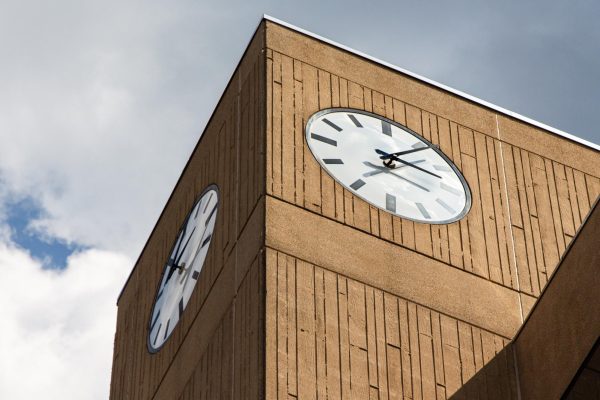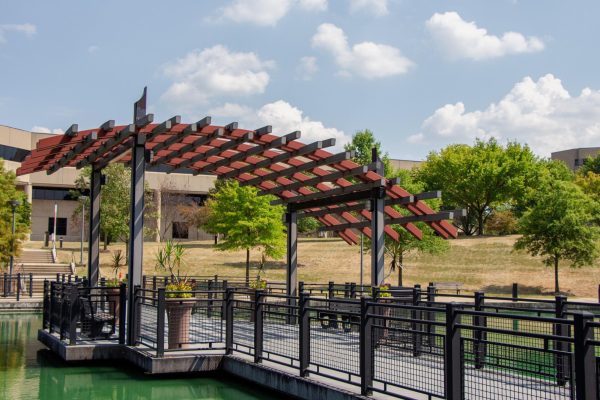Maybe it’s your first year on campus, or maybe you’ve been at NKU for five years but have never ventured outside the classroom.
We’re counting down the 10 most iconic and unique places to NKU that students, staff, faculty and the entire campus community can explore for themselves.
- Under the sea mural

The mural is between the University Center and Lucas Administrative Center. (Jameson Howard)
A journey between the University Center and Lucas Administrative Center— a walk many students never take —transforms NKU into a totally different world. A world “under the sea.”
In 1982, a group of art students transformed this tunnel from concrete walls to a mural. While it doesn’t have an official name, the students referred to it as “the fantasy under the sea,” according to The Northerner’s archives. Their goal? Simply to liven up the hallway.
“It’s not stiff and solid like the buildings on campus,” one art student told The Northerner in 1982.
Now, over 40 years later, the mural still stands— but with an almost eerie feel. Bright fish, a mermaid, a ship-wreck and plenty of seagrass can be seen in this underwater realm.
From nearly any spot on campus, the clock tower atop Lucas Administrative Center is visible. Finished in 1981, the building is home to all the “bosses” on campus, from the presidential cabinet to the president herself.
On top of the eight-floor building perches the bright white clock with bold black numerals, telling the campus community what time it is (and telling students how late they are to class).
- Anthropology museum
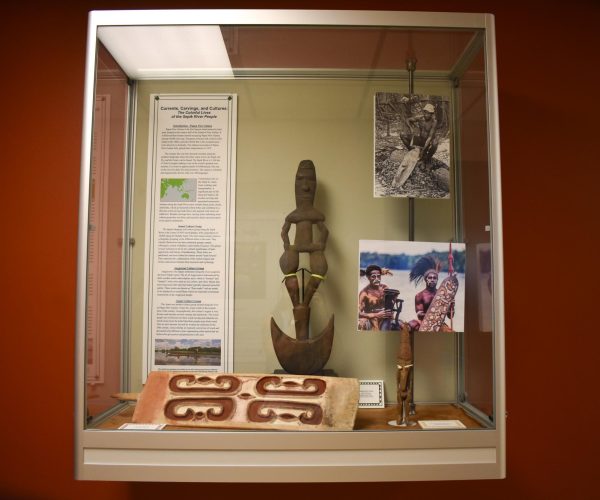
Admission to the Museum of Anthropology is completely free. (Hailey Roden)
Displayed on the second floor of Landrum Academic Center is NKU’s Museum of Anthropology. Founded in 1976, the museum curates cultural materials to highlight, including the current display of Native American art. Admission to the museum is totally free.
The museum also focuses on outreach to K-12 students and hosts lectures, tours, exhibitions and more throughout the year.
- The rock

Upcoming campus events are often painted on the rock. (Jameson Howard)
Right in the midst of the Boothe Residential Village sits the University Housing rock. Often painted to advertise upcoming community events or celebrate holidays and heritage months, the rock is a symbol for the community.
- Abe Lincoln statue
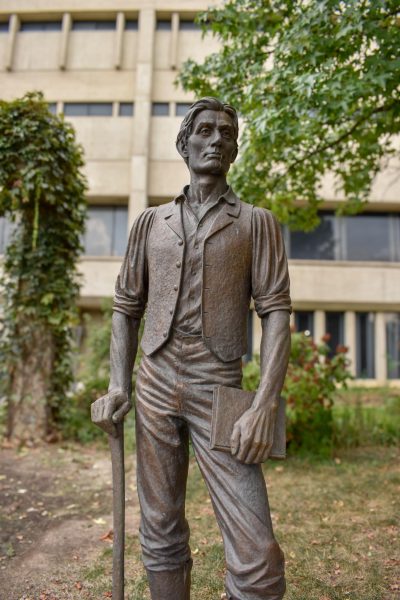
NKU’s Abraham Lincoln statue was created by an alumni. (Hailey Roden)
Standing guard outside Nunn Hall (home of Chase College of Law), a bronze life-size statue of young Abraham Lincoln tightly holds onto his book and his ax. NKU alum Matt Langford is the creator of this statue, which was unveiled in 2004. His work can be found throughout Northern Kentucky as well as in New York City.
For now, Lincoln stands tall behind a chain-linked fence, as the law school remains under construction.
- Graffiti staircase
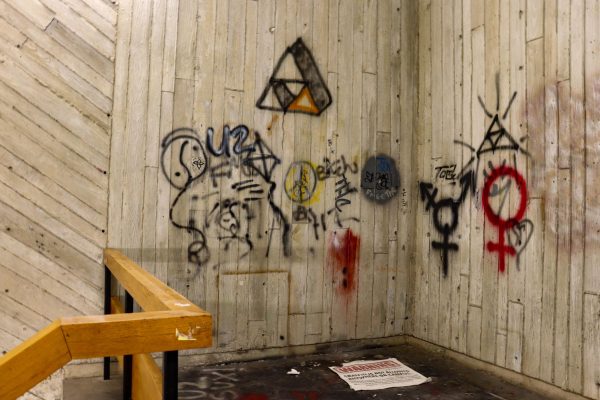
The graffiti staircase has been a source of much controversy for the campus. (Adelyn McCollum)
In the depths of NKU’s Fine Arts Center, a journey through the remote stairwell at the end of the hallway reveals layers of graffiti compiled over time.
The graffiti staircase has been a big source of controversy for the School of the Arts (SOTA). In 2016, The Northerner spoke with leaders of the school, who supported students’ expression in one of the least-traveled hallways. At this time, the stairwell was covered with layers upon layers of phrases and drawings.
In 2019, however, leaders of SOTA said the graffiti was purely vandalism and the artwork was badly done.
Signs hang throughout the stairwell, warning students in big red letters that graffiti is not allowed and rule-breakers will be disciplined, but this hasn’t stopped students entirely from leaving their mark on the art school.
- “The box”

This sculpture’s official title is “Untitled.” (Hailey Roden)
Simply known as “the box” by members of the campus community, this aluminum sculpture sits in the grassy patch between Nunn Hall and the Fine Arts Center.
The sculpture was actually titled “Untitled” by its designer, American artist Donald Judd. Judd (June 3, 1928 – Feb. 12, 1994) was considered the international exponent leader of minimalism, and his 1975 work represented just that.
The box was created to suggest simple perfection, NKU explained in its list of campus terminologies. If you get lucky, you might even catch a student taking a nap on top of the box between classes.
From an old farm pond to now one of the most picturesque spots on campus, Loch Norse has had quite the transformation over the last 20 years.
In 2005, the area was rebuilt to transform the small farm pond to a now five-acre nature spot. And where did the name Loch Norse come from? In 2006, a year after the unveiling, NKU’s Alumni Association and Student Government Association held a voting contest to determine the lake’s name. Loch Norse was the rightful winner and the choice of students and alumni.
Today, the area is known for hosting native plants and animals, including the Canadian Goose— a hallmark of NKU.
- Dragon sculpture
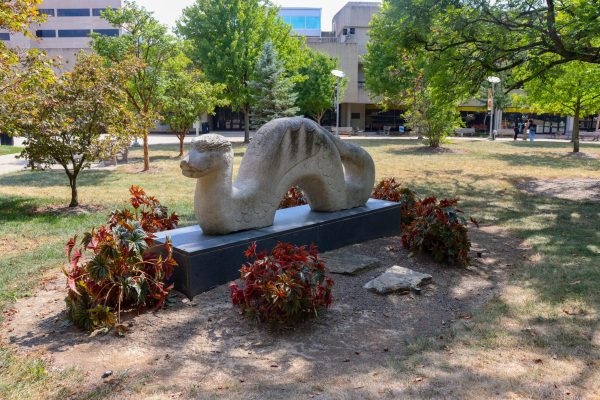
The dragon sculpture was created by Marjorie Pease Applegate, and has been at the university for nearly 25 years. (Adelyn McCollum)
Did you know the dragon sculpture roosted in the green space near the Student Union and University Center has an official name? Oseberg, the Dragon of Northern Lights, is the official name of this limestone sculpture that was created by local artist Marjorie Pease Applegate.
Applegate gave Oseberg to NKU in 2001, where it has perched among the trees for nearly 25 years. The dragon is meant to represent NKU spirit, the university revealed in a 2017 Facebook post about the artwork.
Of course there is also a nod to Hey U, NKU’s short-lived mascot from 1992-2005. Hey U was a dragon decked in black and gold with a green body that bobbled its head around many sporting events. Rumor had it the university changed the mascot because they feared the dragon was too scary for young fans. Former Athletic Director Jane Meier debunked this rumor in an interview with Northern Kentucky Tribune, saying the change was made to Victor E. Viking because the school needed something more aligned with the Norse nickname.
Interestingly enough, the viking went on to be named by ESPN as one of the scariest mascots in the United States in 2015.
Anyway, the legend of Hey U lives on, and many students like to take a ride on Oseberg for a graduation photo-op or a first day of school picture to send to mom.
- Stegowagenvolkssaurus (Stego)
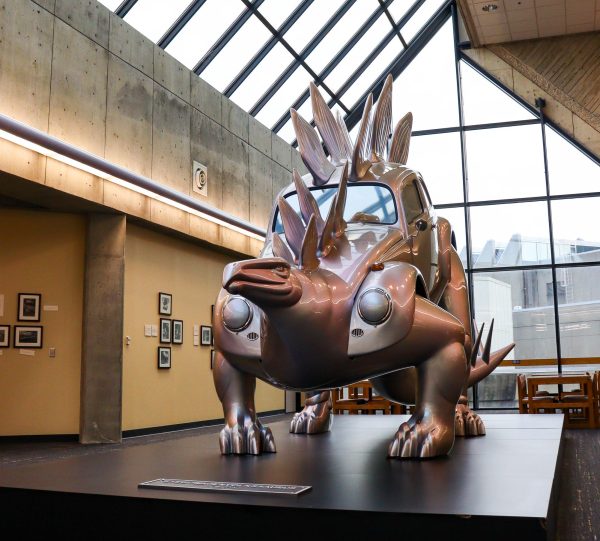
The sculptor of this creation was an artist and professor at the University of Cincinnati. (Adelyn McCollum)
A tour of NKU is never complete without an awe-struck visit to W. Frank Steely Library’s third floor. Perched in the glass atrium, overlooking all the gently-used books and feverishly studying students, sits Stego.
If we’re going by his real name, we’ll call him Stegowagenvolkssaurus. Now why is it named this, you might ask. One look at the sculpture gives you the answer: it’s a quintessential blend between a Stegosaurus dinosaur and a Volkswagen Beetle.
In 1974, University of Cincinnati professor Patricia Renick completed her 20-foot-long sculpture of Stego, and she quite literally used the gutted body of a Volkswagen to create it. She also utilized fiberglass, modeling clay and Styrofoam to help bring her vision to life.
While Renick has since passed away, she explained in an interview before her death that one day she noticed the Beetle had the same hump-shaped body as a Stegosaurus. And with this, the idea was born.
Renick was known for her larger than life sculptures, and for this project she took a year of leave from her teaching job to bring her vision to life. When the project was completed in ‘74, it made its rounds through art exhibits, including a stent at the Cincinnati Art Museum. After this, Stego was disassembled and sat lifelessly in Chicago.
When Renick passed in 2007, her friend Laura Chapman did her due diligence to bring the sculptor’s work back to life. After repainting and repairing Stego to its original state, the sculpture was dedicated to NKU in 2009.
Some of the creator’s ashes are even entombed inside Stego.
And we can’t forget that even Iron Man himself (Robert Downey Jr.) knows about Stego’s existence. In a 2013 Facebook post, Downey Jr. shared a photo of Stego and said, “Sorry Transformers, you’re doing it wrong.”


